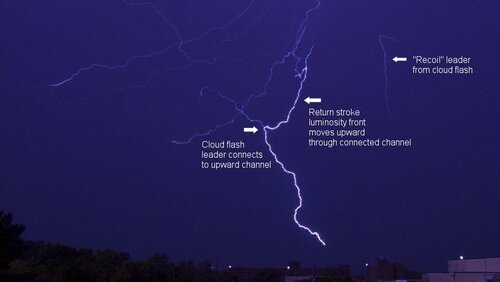Dan Robinson
EF5
I've been going on an end-of-summer MCS stratiform lightning binge with chases to Wichita, Kansas City, Columbia, MO and Cape Girardeau, MO in the past week with varying degrees of success and failure. In Kansas City last night, I witnessed and captured an interesting event on high speed video.
This discharge began with a positive horizontal cloud discharge leader (an "anvil crawler" as we call them) and an upward positive leader from a TV tower nearly paralleling each other as they grew in a westerly direction. This was likely in response to negative leaders propagating overhead higher in the cloud, which are common initiators of upward positive leaders (UPLs) from towers.

The horizontal discharge began branching after several milliseconds, several of which can be seen traversing the frame in the same direction as the main channel.

Then, one of the branches contacted the channel of the upward tower flash about halfway below cloud base, completing the circuit for a positive cloud-to-ground flash return stroke! The thunder from this was typical of positive CG (loud "sonic booming").

The CG return stroke, as is typical, completely overexposed:

As the return stroke decayed, the completed "merged" channels are visible:

In short: a positive "anvil crawler" connected to an upward tower discharge-in-progress to complete a positive cloud-to-ground stroke. I am working on a video of this which I'll probably have to finish after Dorian is over with.
This discharge began with a positive horizontal cloud discharge leader (an "anvil crawler" as we call them) and an upward positive leader from a TV tower nearly paralleling each other as they grew in a westerly direction. This was likely in response to negative leaders propagating overhead higher in the cloud, which are common initiators of upward positive leaders (UPLs) from towers.

The horizontal discharge began branching after several milliseconds, several of which can be seen traversing the frame in the same direction as the main channel.

Then, one of the branches contacted the channel of the upward tower flash about halfway below cloud base, completing the circuit for a positive cloud-to-ground flash return stroke! The thunder from this was typical of positive CG (loud "sonic booming").

The CG return stroke, as is typical, completely overexposed:

As the return stroke decayed, the completed "merged" channels are visible:

In short: a positive "anvil crawler" connected to an upward tower discharge-in-progress to complete a positive cloud-to-ground stroke. I am working on a video of this which I'll probably have to finish after Dorian is over with.

